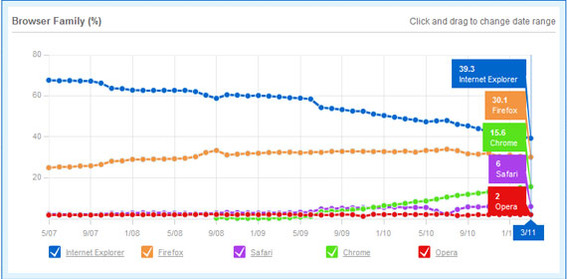Microsoft released a preview version of its forthcoming Internet Explorer 10 web browser at the MIX11 developer conference in Las Vegas last week. The browser preview provides important insights into what might be a new salvo in the browser wars and could affect how online businesses develop websites and applications.
Operating System Optimized
“Websites and HTML5 run best when they run natively, on a browser optimized for the operating system on your device,” wrote Microsoft’s corporate vice president for Internet Explorer, Dean Hachamovitch, on the Microsoft Developers’ Network blog.
When Hachamovitch gave the presentation about IE10 to an enthralled audience at his company’s developer conference, he also implied what might be a significantly different design philosophy from other leading browser makers. Specifically, IE10 will be built to run on Windows and Windows alone, taking advantage of the operating system’s native capabilities and allowing access to a computer’s hardware via the operating system. In contrast, Mozilla Firefox, Google Chrome, Opera, and Apple’s Safari all run on multiple operating systems, usually Windows, Mac OS X, and Linux.
“The only native experience of HTML5 on the web today is on Windows 7 with Internet Explorer 9,” Hachamovitch said during his presentation. “With Internet Explorer 9, websites can take advantage of the power of modern hardware and a modern operating system and deliver experiences that were not possible a year ago. Internet Explorer 10 will push the boundaries of what developers can do on the web even further.”
Hachamovitch also provided several examples of how IE10 could outperform competitors’ browsers thanks to more integrated hardware acceleration in this video, below.
More HTML5 and CSS3
The IE10 preview makes significant strides in its support for HTML5 and the related CSS web standards.
Perhaps the most compelling improvements in IE10 center around being able to create more flexible web site design, using CSS3 flexible box layouts, grid alignments, and multi-column layouts. These capabilities could make it easier to develop, as an example, an online store that displayed well on both a desktop computer and a smartphone.
Microsoft has provided an IE10 platform preview guide for developers that provides the specifics of its proposed improvements in standards compliance.
Much More Security
Microsoft dramatically improved browsing security with IE9, and several industry pundits predict that IE10 will feature nothing less than “iron-clad” security. While specifics are still vague, improved security would make a lot of sense as part of Microsoft’s reinvigorated browser initiative.
Goodbye Vista
IE10 will not run on Windows Vista. The preview platform causes an error when you try to download it, and Microsoft has confirmed to some publications that he does not plan to support Vista with IE10. IE9 caused something of a stir when it was learned that it did not support the aging XP operating system, but Vista was available for download as recently as 18 months ago. Depending on the actual release of IE10, it could have some impact on adoption.
What IE 10 Means for the Web
Microsoft is motivated to change the way consumers access the web and raise the bar on expectations. Why? Because Microsoft’s share of the web browser market has been eroding for years, and it needs to create new value for users.
Although browser use statistics tend to vary depending on how the data is collected, most sources agree that IE has gone from dominance to being dogged by competitors. StatCounter Europe, which tracks web usage, has had IE as the second most popular browser for some time. Other sites such as W3Counter still show IE on top, but have Firefox nipping at its heels. What’s more, many sources believe that if you discount work computers, where the browser choice may be enforced by a corporate IT department, IE could be third behind Firefox and Chrome.

W3Counter estimates that Microsoft’s share of the browser market has dropped from 67.6 percent of users in May 2007 to about 39 percent in March 2011.
To combat this market share slide, IE9 improved the browser’s performance and introduced a level of standards compliance not seen in any earlier version. The company also put a lot of effort into winning back developers, who have tended to promote Firefox, Chrome, or Safari over IE.
In IE10, the company is beginning to take a leadership role in HTML5 and CSS3, but is also drawing a new division among browsers by stating that the browser ought to be optimized for the operating system.
This could set up two contradictory trends on the web.
On the one hand, by embracing HTML5 and CSS3, IE10 — and IE9 to a great degree — should make it easier for website designers and developers, since it may not be necessary to write multiple versions of a site. This trend might lower site development costs, and make it easier to build sites that dynamically change to suit mobile devices and desktops alike.
On the other hand, if each browser became device and operating system optimized, site owners might find themselves needing to account for a greater number of variations when they are having their site updated. For example, Opera Mini is the clear leader in mobile browsers, and it has a different level of support for some HTML5 and CSS3 capabilities than IE9, IE10, or several other browsers that one could mention.
Summing Up
Microsoft is getting serious about improving its web browser. IE10 appears to be a continuation of the vast improvements the company made in IE9. The IE10 announcement also implies that Microsoft has every intention of keeping up or even leading its competition.





